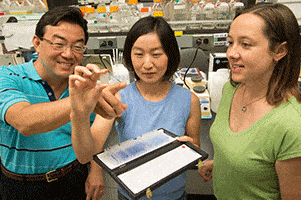Among scientists, the role of proteins called sirtuins in enhancing longevity has been hotly debated, driven by contradictory results from many different scientists. But new research at Washington University School of Medicine in St. Louis may settle the dispute.
Reporting Sept. 3 in Cell Metabolism, Shin-ichiro Imai, MD, PhD, and his colleagues have identified the mechanism by which a specific sirtuin protein called Sirt1 operates in the brain to bring about a significant delay in aging and an increase in longevity. Both have been associated with a low-calorie diet.
The Japanese philosopher and scientist Ekiken Kaibara first described the concept of dietary control as a method to achieve good health and longevity in 1713. He died the following year at the ripe old age of 84—a long life for someone in the 18th century.
Since then, science has proven a link between a low-calorie diet (without malnutrition) and longevity in a variety of animal models. In the new study, Imai and his team have shown how Sirt1 prompts neural activity in specific areas of the hypothalamus of the brain, which triggers dramatic physical changes in skeletal muscle and increases in vigor and longevity.
“In our studies of mice that express Sirt1 in the brain, we found that the skeletal muscular structures of old mice resemble young muscle tissue,” said Imai. “Twenty-month-old mice (the equivalent of 70-year-old humans) look as active as five-month-olds.”
Imai and his team began their quest to define the critical junctures responsible for the connection between dietary restriction and longevity with the knowledge from previous studies that the Sirt1 protein played a role in delaying aging when calories are restricted. But the specific mechanisms by which it carried out its function were unknown.
Imai’s team studied mice that had been genetically modified to overproduce Sirt1 protein. Some of the mice had been engineered to overproduce Sirt1 in body tissues, while others were engineered to produce more of the Sirt1 protein only in the brain.
“We found that only the mice that overexpressed Sirt1 in the brain (called BRASTO) had significant lifespan extension and delay in aging, just like normal mice reared under dietary restriction regimens,” said Imai, an expert in aging research and a professor in the departments of Developmental Biology and Medicine.
The BRASTO mice demonstrated significant life span extension without undergoing dietary restriction. “They were free to eat regular chow whenever they wished,” he said.
In addition to positive skeletal muscle changes in the BRASTO mice, the investigators also observed significant increases in nighttime physical activity, body temperature and oxygen consumption compared with age-matched controls.
Mice are characteristically most active at night. The BRASTO mice also experienced better or deeper sleep, and both males and females had significant increases in longevity.
The median life span of BRASTO mice in the study was extended by 16 percent for females and 9 percent for males. Translated to humans, this could mean an extra 13 or 14 years for women, making their average life span almost 100 years, Shin said. For men, this would add another seven years, increasing their average life span to the mid-80s.
Delay in cancer-dependent death also was observed in the BRASTO mice relative to control mice, the researchers noted.
Imai said that the longevity and health profile associated with the BRASTO mice appears to be the result of a shift in the onset of aging rather than the pace of aging. “What we have observed in BRASTO mice is a delay in the time when age-related decline begins, so while the rate of aging does not change, aging and the risk of cancer has been postponed.”
Having narrowed control of aging to the brain, Imai’s team then traced the control center of aging regulation to two areas of the hypothalamus called the dorsomedial and lateral hypothalamic nuclei. They then were able to identify specific genes within those areas that partner with Sirt1 to kick off the neural signals that elicit the physical and behavioral responses observed.
“We found that overexpression of Sirt1 in the brain leads to an increase in the cellular response of a receptor called orexin type 2 receptor in the two areas of the hypothalamus,” said first author Akiko Satoh, PhD, a postdoctoral staff scientist in Imai’s lab.
“We have demonstrated that the increased response by the receptor initiates signaling from the hypothalamus to skeletal muscles,” said Satoh. She noted that the mechanism by which the signal is specifically directed to skeletal muscle remains to be discovered.
According to Imai, the tight association discovered between Sirt1-prompted brain activation and the regulation of aging and longevity raises the tantalizing possibility of a “control center of aging and longevity” in the brain, which could be manipulated to maintain youthful physiology and extend life span in other mammals as well.
If our reporting has informed or inspired you, please consider making a donation. Every contribution, no matter the size, empowers us to continue delivering accurate, engaging, and trustworthy science and medical news. Independent journalism requires time, effort, and resources—your support ensures we can keep uncovering the stories that matter most to you.
Join us in making knowledge accessible and impactful. Thank you for standing with us!

